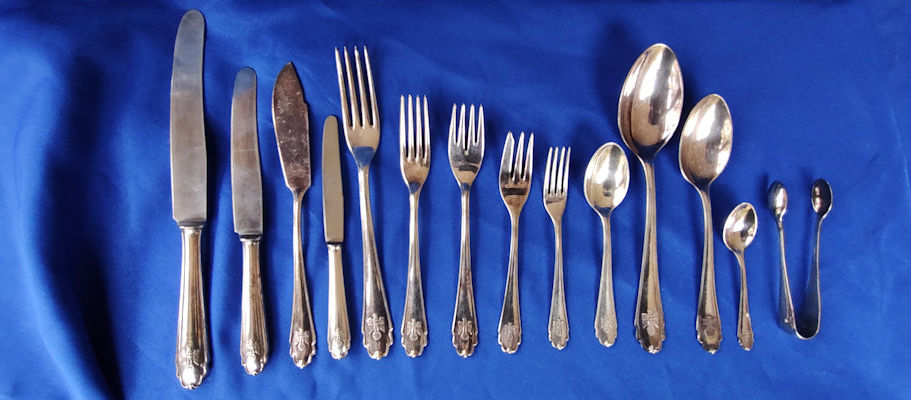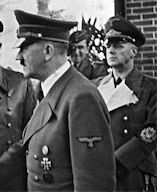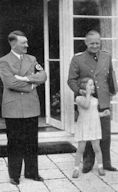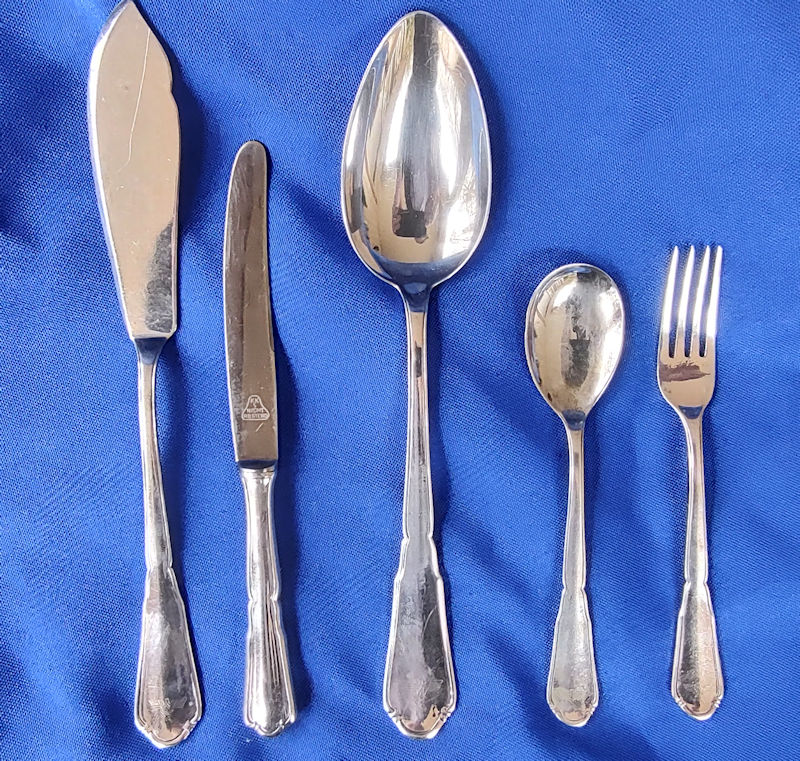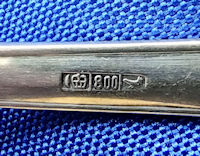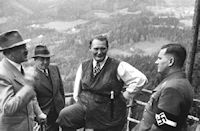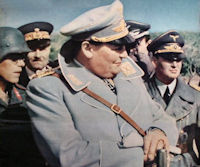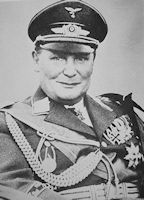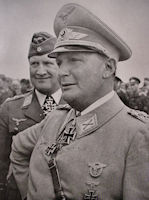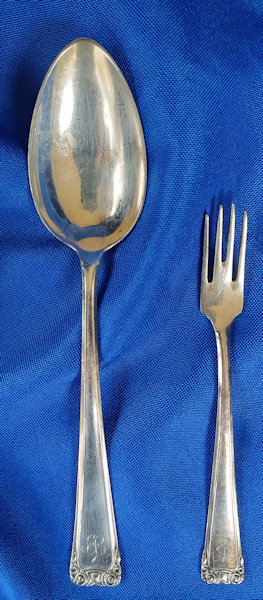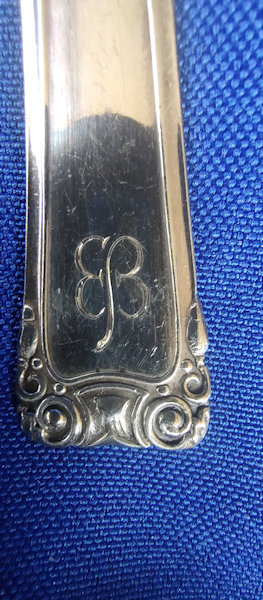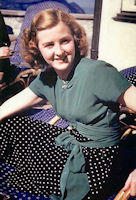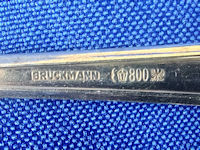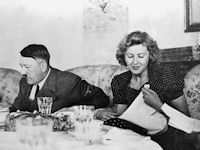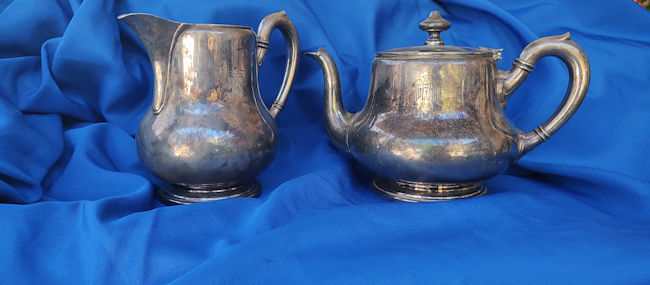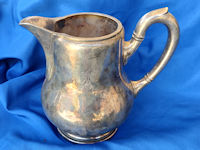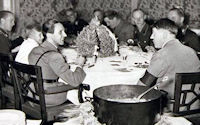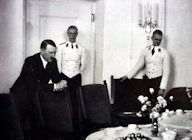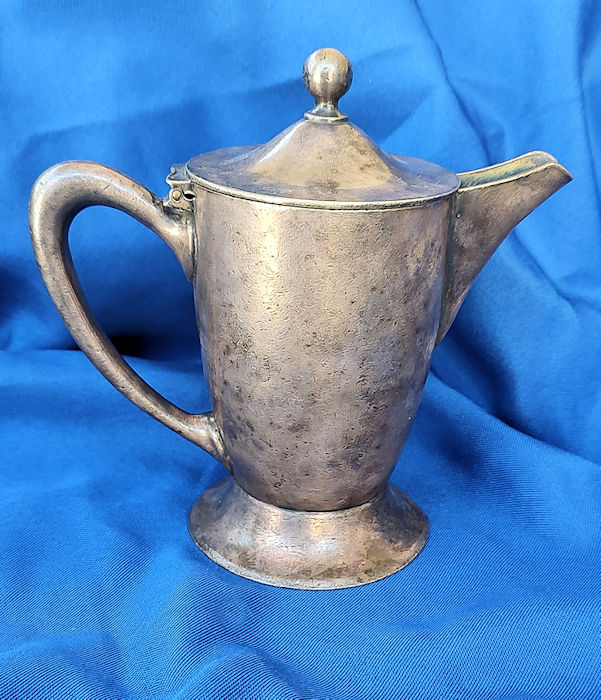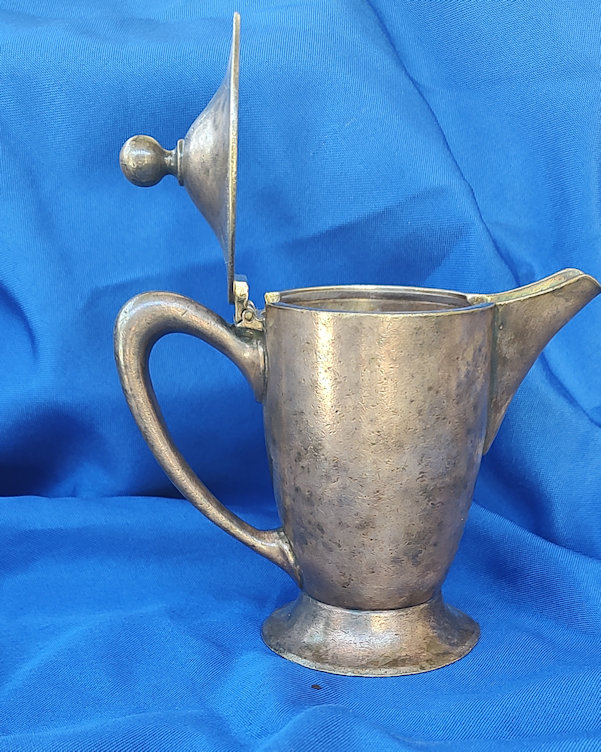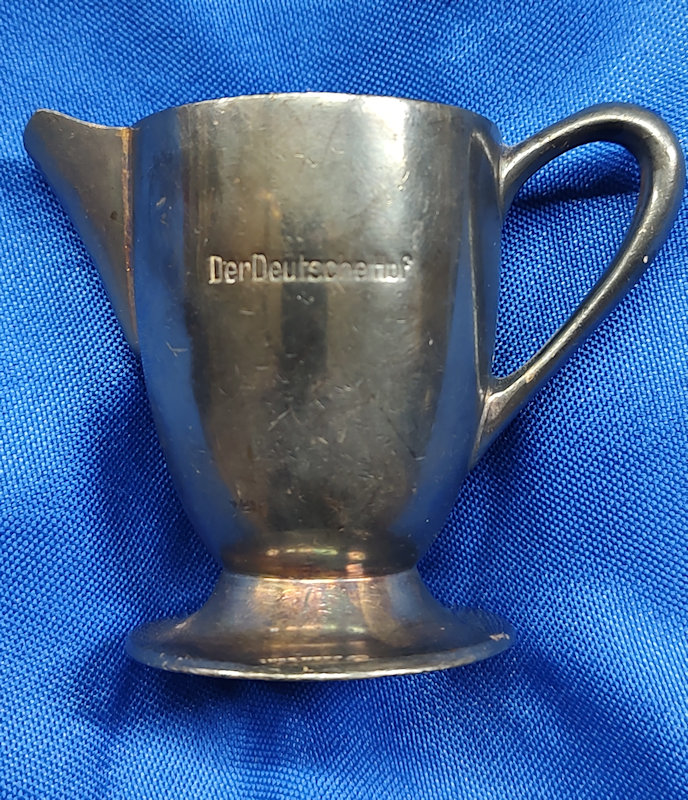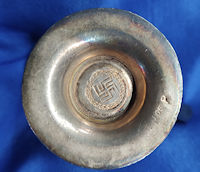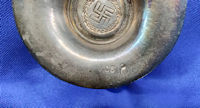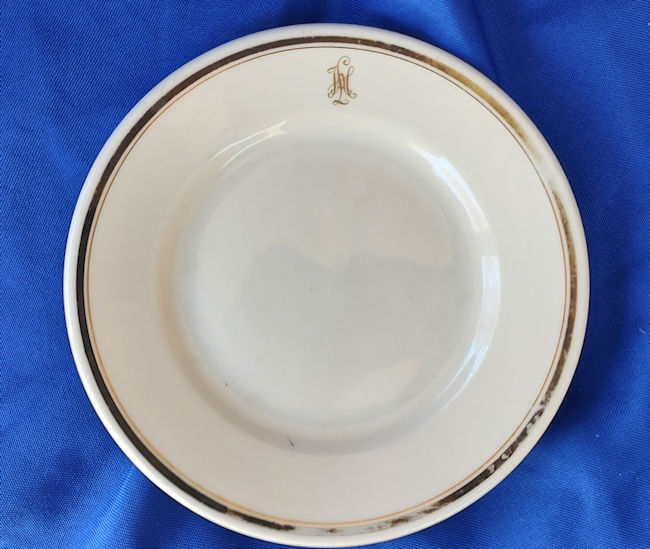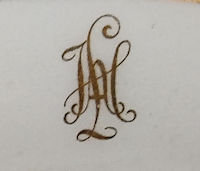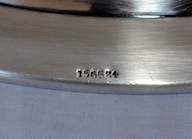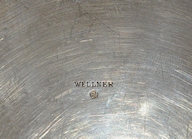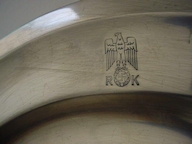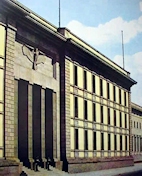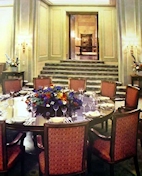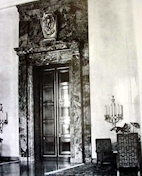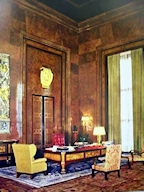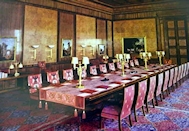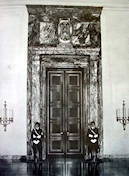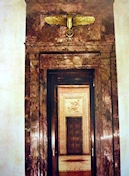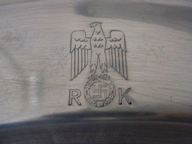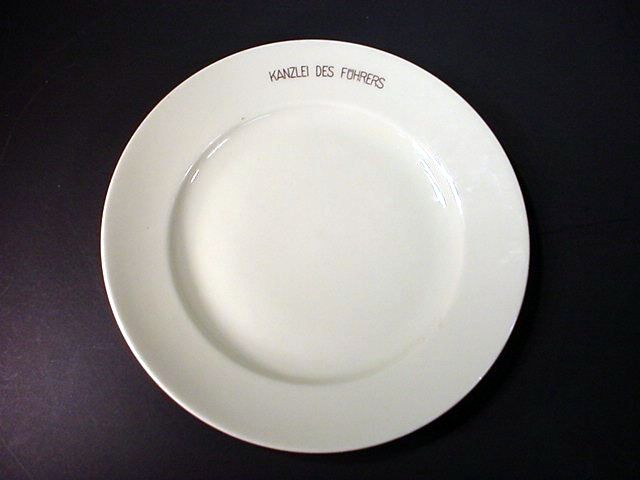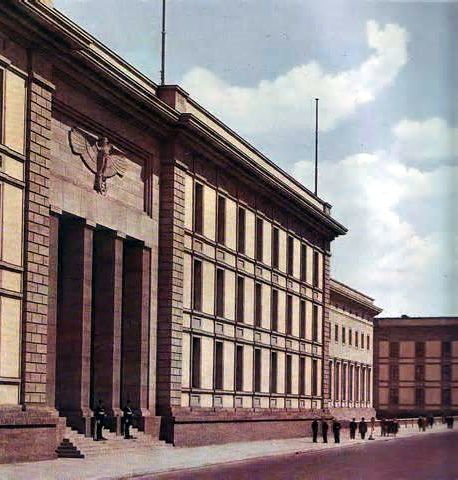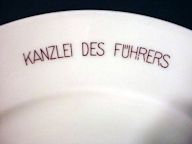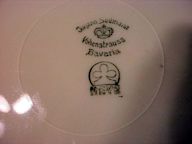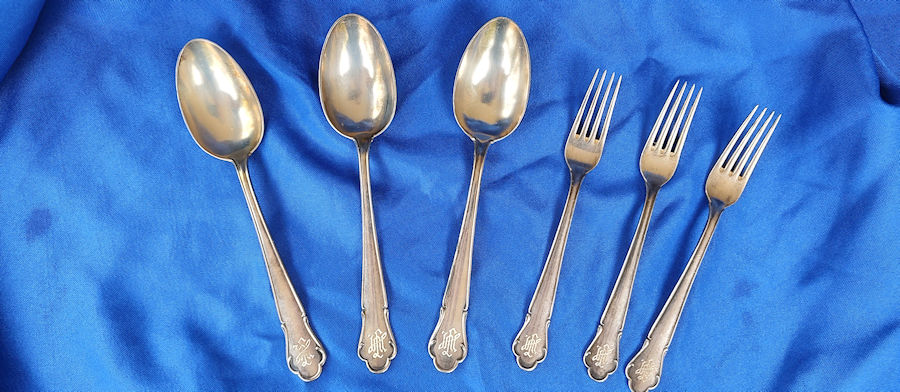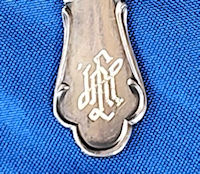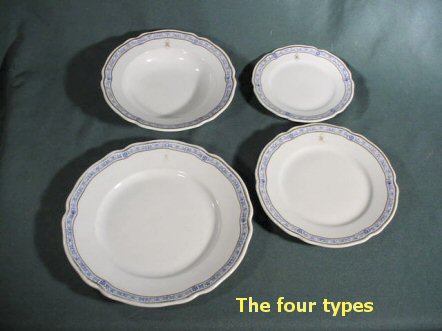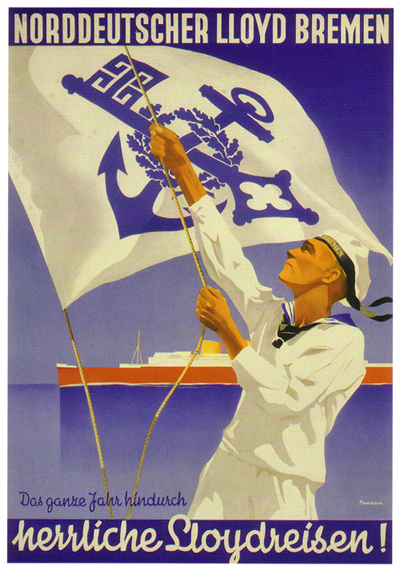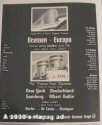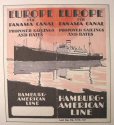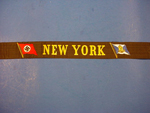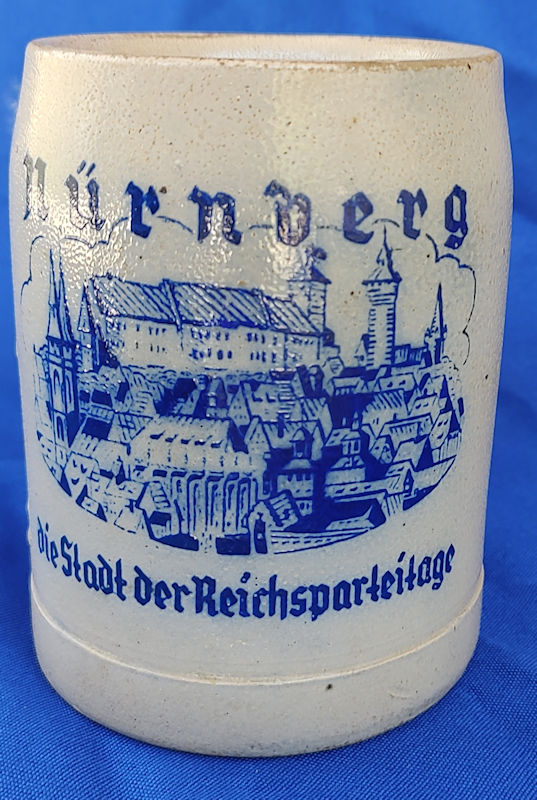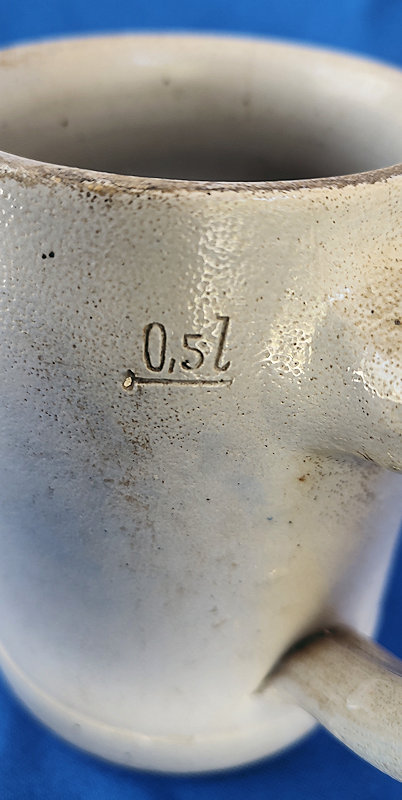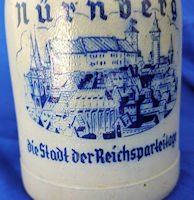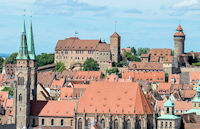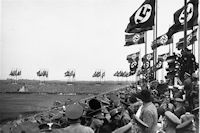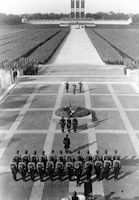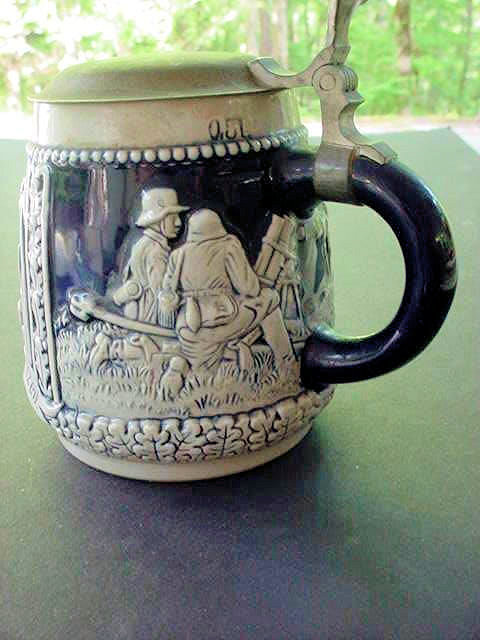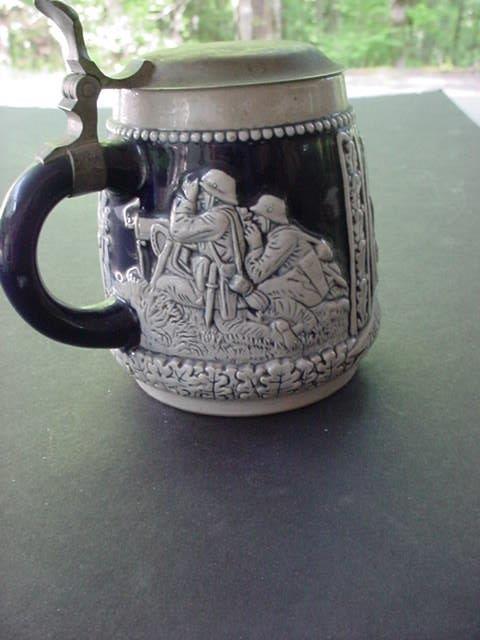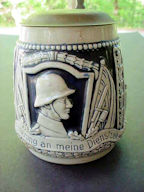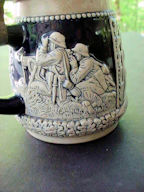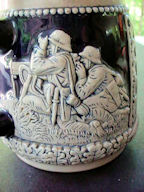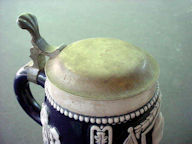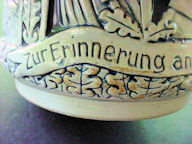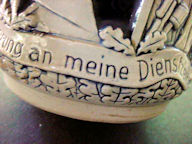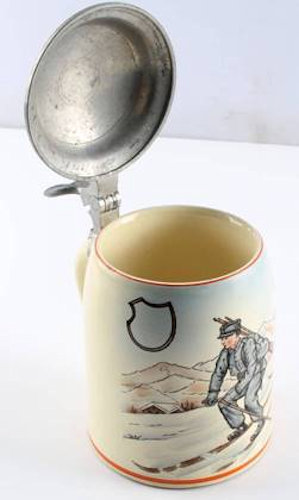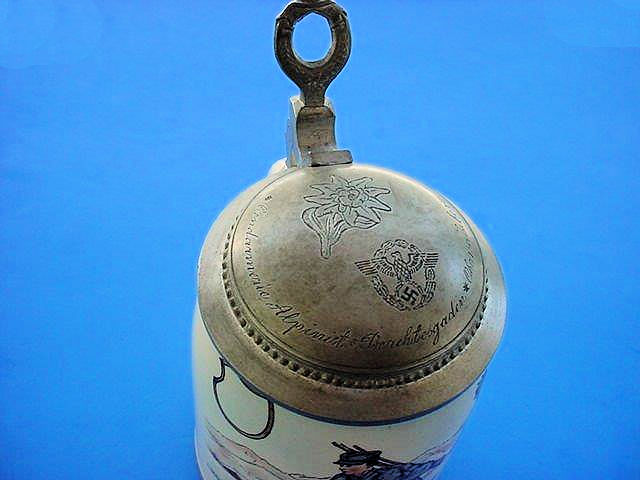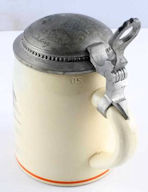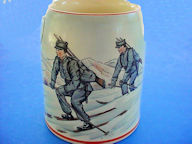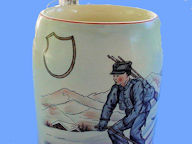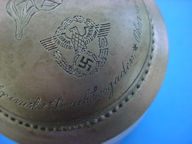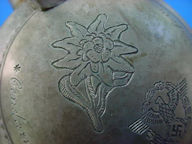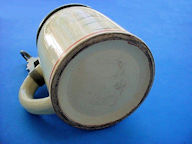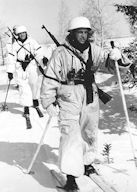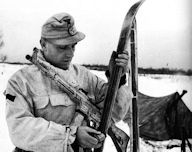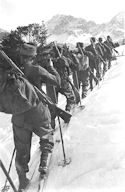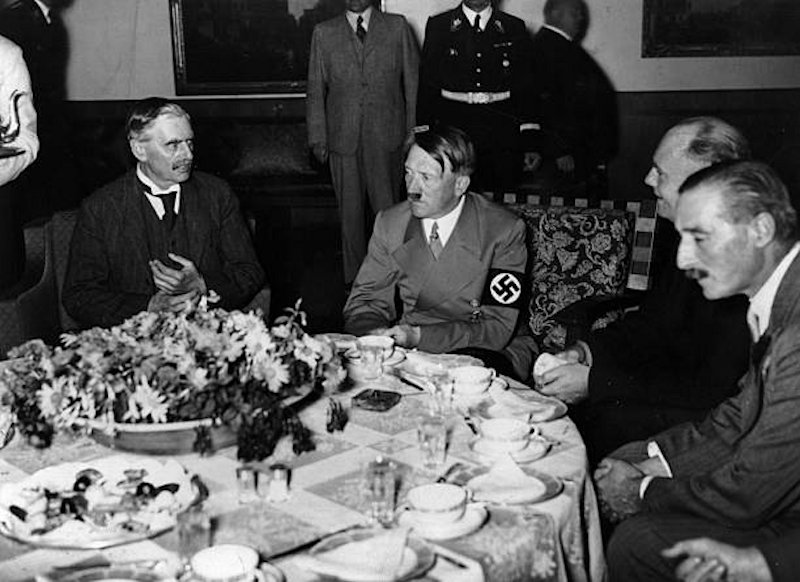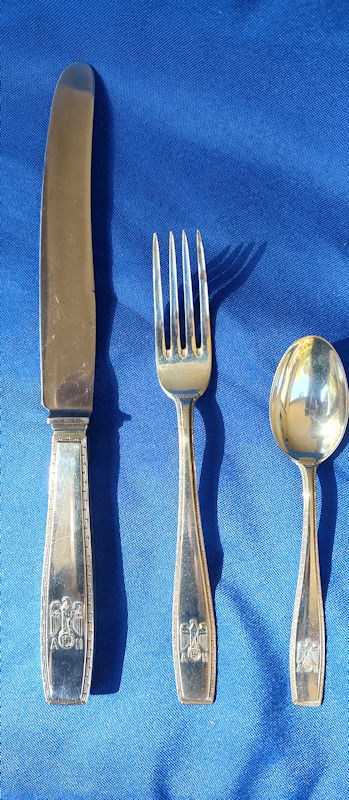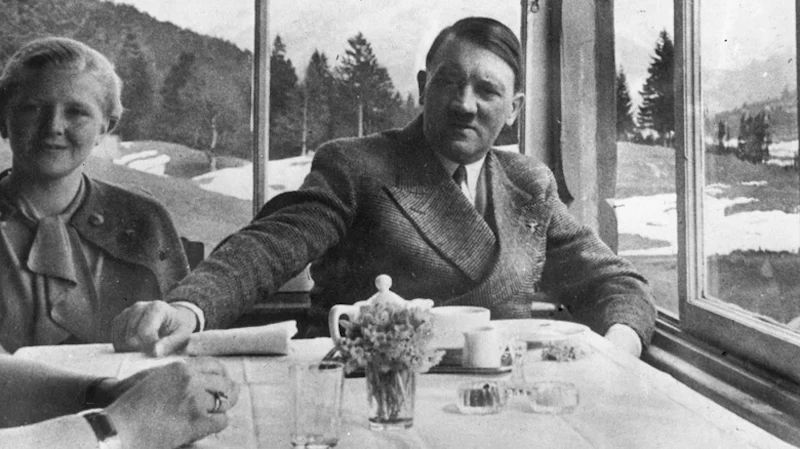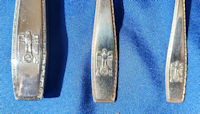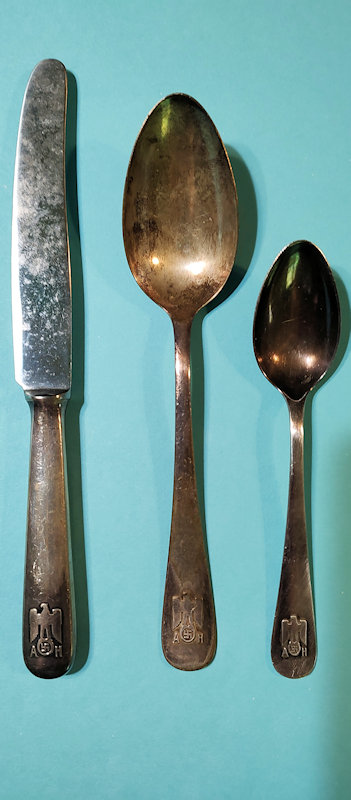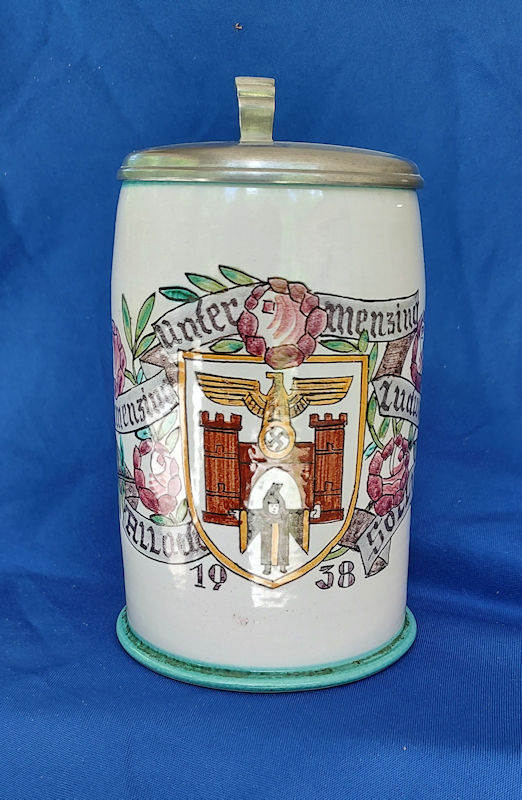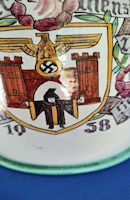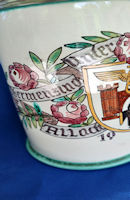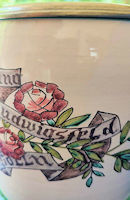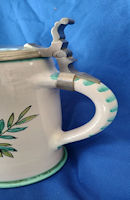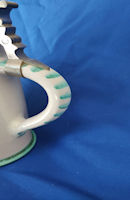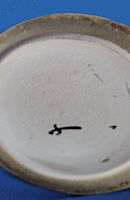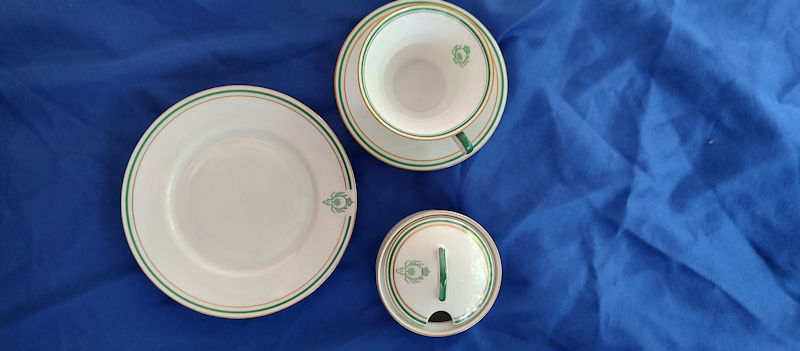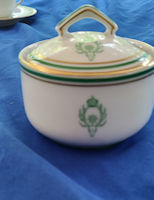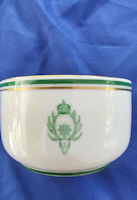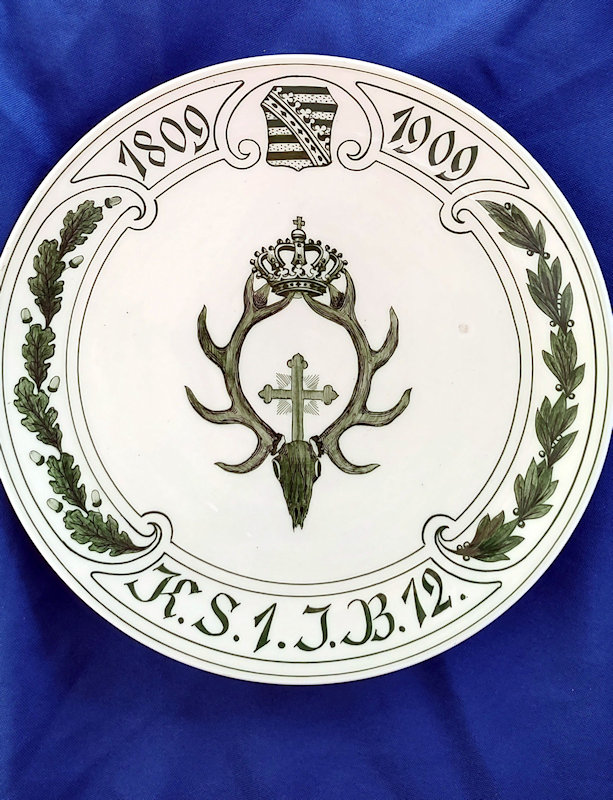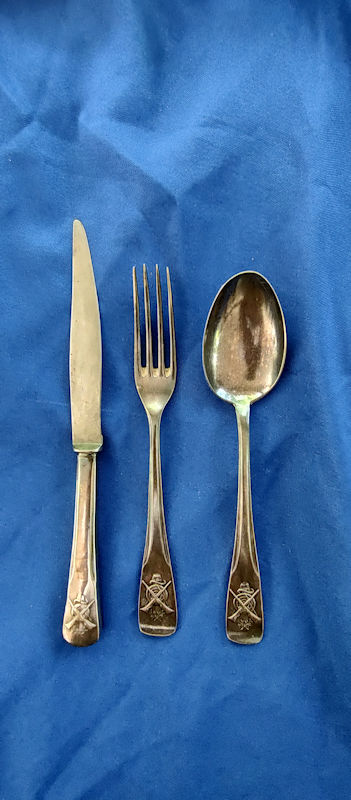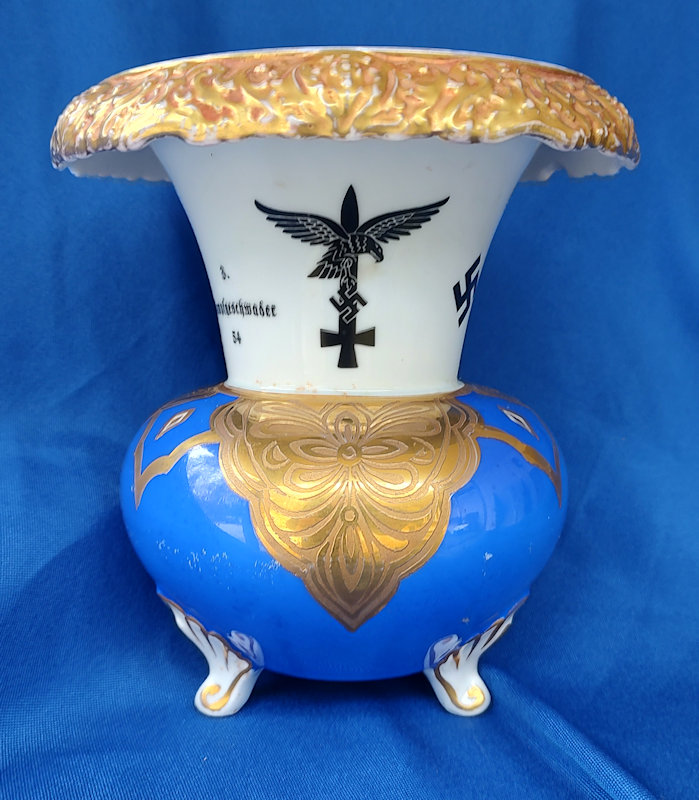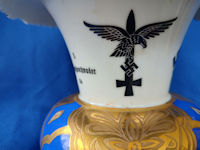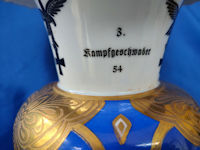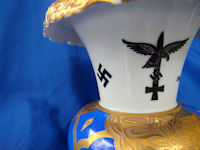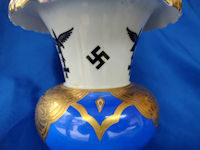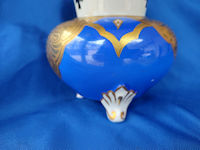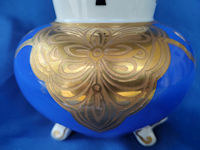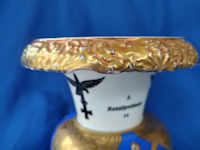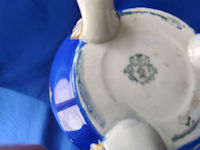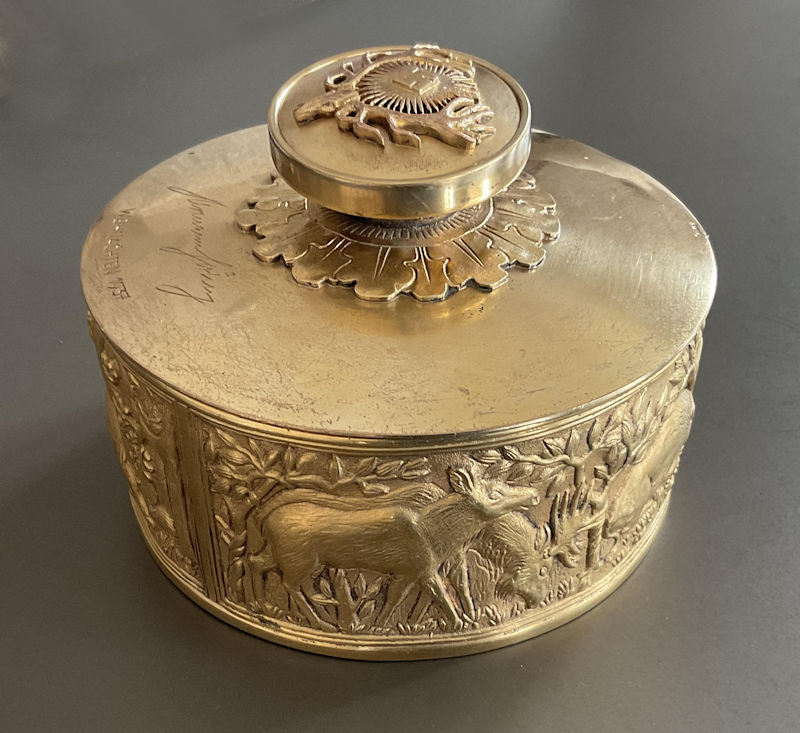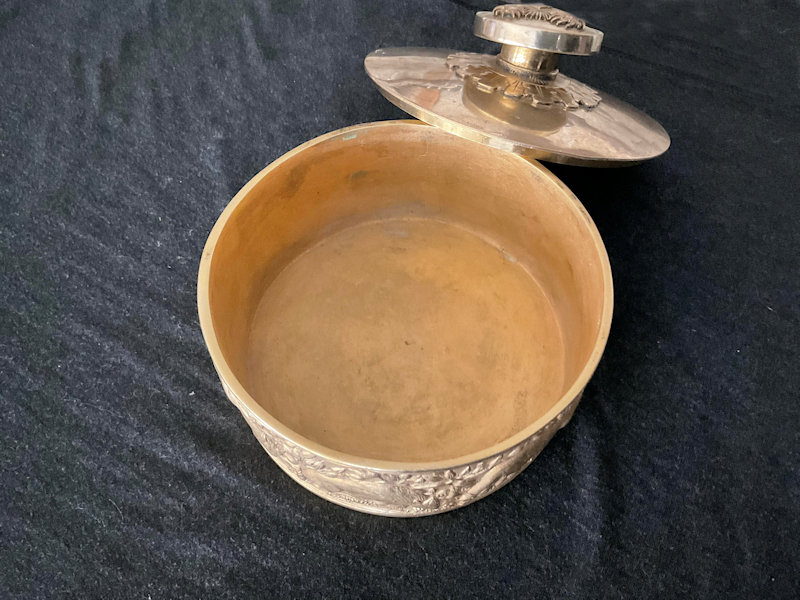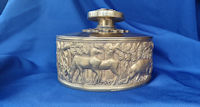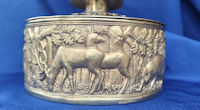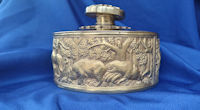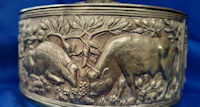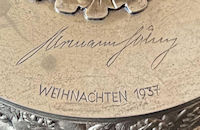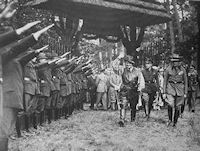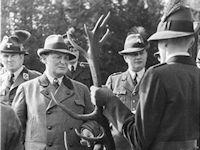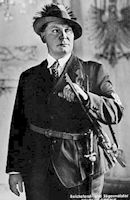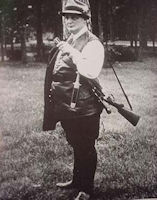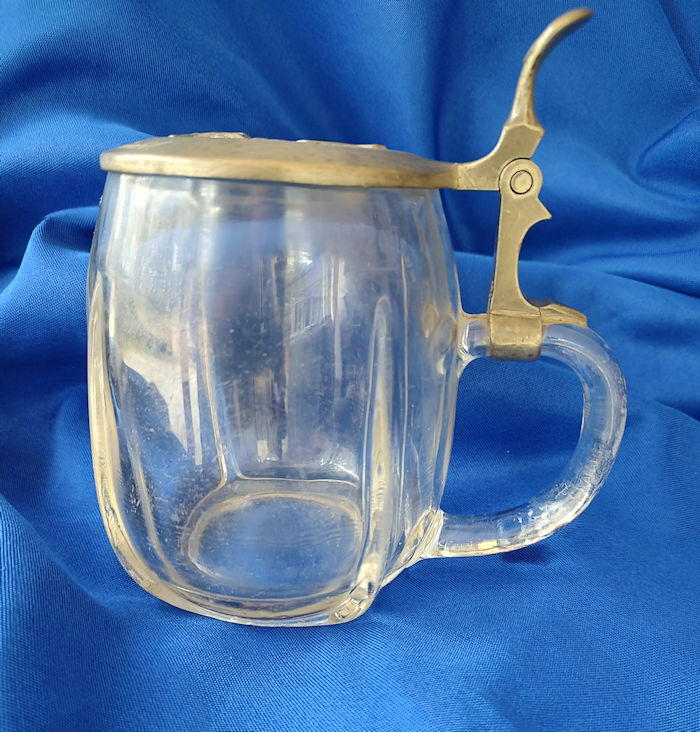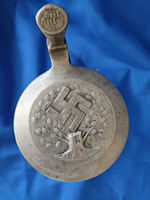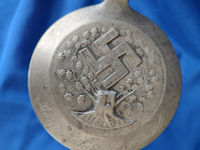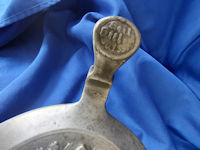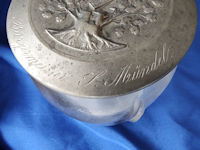|
|
|
|
Tableware of the Third Reich
|
|
Dinner Flatware from Joachim von Ribbentrop, Hitler’s Minister of Foreign Affairs (Item Third Reich Tableware 1-1) |
| DESCRIPTION: Do these pieces look familiar? Often mistaken for Adolf Hitler silverware, this pattern was the predecessor of the latter just without the “AH” monogram. These were a special setting for the highest diplomatic dinners and a safe bet they were used by Adolf Hitler as well as other noted dignitaries. The silverware is featured on page 111 of Yannes’ book The Encyclopedia of Third Reich Tableware, having been made by Gebruder Sauerland of Berlin, but were also produced by the Führer’s favorite maker, Bruckmann, as his pieces were, and that is who produced this grouping. These are very desirable collectibles, here, that will only become more valuable with time.
PRICE: $650.00 for each piece |
|
|
Reichsmarschall Hermann Göring Silverware (Item Third Reich Tableware 1-2; GOR 13-3) |
| DESCRIPTION: We have a positive identification of this silverware as it is presented in James A. Yannes’ book The Encyclopedia of Third Reich Tableware, so we are more than honored to offer it here. Presented is the logo of crossed batons with swastika signifying it is the coat of arms of the Reichsmarschall. According to Yannes, this is the type 3 Göring eagle with five feathers, and the pieces are “800” silver with the hallmark of Karl Kaltenbach & Söhne—Altensteig/Württemberg. Our pieces are in pristine condition with a few minor-wear scratches detected with a magnifying glass.
PRICE: $800.00 for each piece; tremendous Third Reich collectibles! |
|
|
Eva Braun Silverware (Item Third Reich Tableware 1-3; AH 31-17; HITLER FLATWARE 1-21) |
| DESCRIPTION: Eva Braun items are probably the most forged of all Third Reich memorabilia and have had quite a run for the last few years. However, legitimate items are still available, but rare—you really need to know what to look for. Here we have two bona fide items having belonged to Eva, with what appear to be a pickle fork and a large spoon. What makes these different? Two major revelations: the stylized initials “EB” is one. The other is that Eva loved butterflies and would incorporate that design into her monograms. Look at the “EB,” here .Forgers go to great lengths to actually produce a connected “EB” to make it appear more like a butterfly, but rarely do the following:. The letters are not connected as the forgeries are, while here we have a gap so that the eye can discern a butterfly pattern yet distinctly see her initials. But the real giveaway is the “B.” See the long extension of the “B,” the tail of it so to speak? Forgers do not go to that much trouble. But, if they do, they do not execute the other revealing identification—the Bruckmann maker’s mark. Bruckmann was Adolf Hitler’s favorite silversmith. They would have to find a period Bruckmann piece and enhance it. This is also an “800” silver piece and forgers just can’t match up all the credentials. The Bruckmann company was in business from the 1870s to 1973. It really never recovered from the war, sold to another firm, and finally went bankrupt. Newer pieces don’t carry the updated hallmarks nor the silver content of the 1930s and 40s, which makes another distinguishing telltale sign of the forged items as they have to find a “blank” piece of silverware from the time, which is hard to do. Albert Speer was Eva’s closest friend at the Berghof and he said, “Eva Braun is especially delighted in showing off her new patterns at any opportunity, frequently using a different pattern at each place of the table and asking her quests which patterns they preferred.” He also designed her famous monogram. The lettering was similar to his own silverware pattern. She used other high-end silversmiths, as well, as shown in James A. Yannes’ The Encyclopedia of Third Reich Tableware. She loved silverware and there are still some good, authentic pieces out there. It’s just a matter of finding them and being able to distinguish the real from the fantasy.
PRICE: SOLD |
|
Reichskanzlei (Chancellery) State Silver Tea Service (Item Third Reich Tableware 1-4; HITLER FLATWARE 1-22; AH 31-18) |
| DESCRIPTION: Here, we are offering a creamer along with a teapot. These were made by the famous Wellner silversmiths and were the standard Wellner design for hotels and cruise lines and the Adolf Hitler tea sets that were at Obersalzberg and the Führerbau as well as his Munich apartment. Pictures of the Hitler set are shown in Mark D. Griffith’s book Reich State Silver and you will notice that the pieces listed here are identical to the Hitler tea service. Only difference is the eagle—an “A” is on one side of the eagle and the “H” on the other, while these have the “R” on one side of the eagle and the “K” on the other standing for Reichskanzlei–Reich Chancellery. These two items are in mint condition with a beautiful patina as they have not been polished to reflect their age, but of course can be—that will be left to the buyer. Truly, the ability to find these items is fading as collectors cling to their treasures with pride. They will only appreciate in value both monetarily and historically. If you can imagine Hitler and Third Reich dignitaries at a state dinner pondering over the vicissitudes of the war while using these you would be right on the mark. Decorate your next dinner table with a glorious piece of history! These are genuine Third Reich mementos.ter of finding them and being able to distinguish the real from the fantasy.
PRICE: SOLD |
|
|
Serving Piece from Hitler’s Favorite Hotel, Der Deutsche Hof Hotel in Nuremberg (Item Third Reich Tableware 1-5; HITLER FLATWARE 1-23; AH 31-19) |
| DESCRIPTION: The Deutsche Hof was the hotel where Adolf Hitler and all the high party members stayed during the days of the Reich Party Days rallies in Nuremberg. The NSDAP headquartered here and it became known infamously later as the “Nazi” hotel. It was here that Hitler stood at the balcony viewing his troops as they passed in review so often portrayed in vintage newsreels. The hotel ordered all tableware to carry the symbol of the NSDAP, the swastika within a wreath. Many items had the “Der Deutsche Hof” imprinted as well, as you seen on the tea pot. Our teapot is well used, a good sign, but in excellent condition with a lovely patina. It is six inches high and bears the liter mark of “0,23L; “858” probably a model number on the lid’s underside and the maker’s mark of “GEBR.HEPP 90” for Gebrüder Hepp”—the latter number designating it is silver plated. Liberals in Germany have sought to destroy the hotel as it was a tourist attraction for those wanting to stay in the “infamous” room Hitler occupied. Right now, most of it has been renovated and made into offices in the last 10 years. I was one of the last to stay in the “infamous” room and it was a very poignant moment to experience the feeling of being where history was being made. Stepping out on the balcony, you could see the German Army at its best march by!
PRICE: $2,000.00 |
|
Another Fine Piece of Tableware from Der Deutsche Hof, Hitler’s Hotel in Nuremburg (Item THIRD REICH TABLEWARE 1-5A; HITLER FLATWARE 1-24; AH 31-20) |
| DESCRIPTION: Here is a very demure, seldom seen, what appears to be a personal creamer for the table. It has all the attributes of the set above with “0,05” for the liter capacity. “Der Deutsche Hof” is well marked as it the “GEBR. HEPP 90” manufacture’s logo. It is in perfect condition having not been polished, so has a beautiful patina.
PRICE: $500.00 |
|
SS-LAH Formal Plate (Item Third Reich Tableware 1-6; SS 38-40) |
| DESCRIPTION: These extremely rare plates were part of the ceremonial dinners sponsored by Heinrich Himmler for his elite Allgemeine-SS. They were produced by either Bauscher Weiden or KPM; both firms producing high-end porcelain products. The one we present is by KPM. It’s unbroken, but the painted rim is stressed as you can see; however, the gold is still present. The most important part, the LAH cipher is still golden and perfect! It’s about 6¼ inches in diameter.
PRICE: $450.00 |
|
|
||||||||||||
|
Reich Chancellery Serving Tray (Item Third Reich Tableware 1-7; CHANCE 1-3) |
||||||||||||
| DESCRIPTION: Here, from the National Socialist Reichskanzlei, is an original platter of the type used by the Allgemeine-SS servers within the chancellery along with other service personal to bring soft drinks and alcoholic beverages to the Führer and his honored guests. This was one of the special Wellner serving pieces that made up the set of such items kept and used in this the most architecturally beautiful yet most important building of the Reich. There may have been 8 or 10 of these trays, but how many of them can be accounted for today? Was Hitler himself ever served from this particular tray brought by one of the nattily dressed SS guards? The odds would tend to say ‘yes,‘ even ‘indubitably yes,’ as the Fuhrer would several times a day summon natural mineral water or a hot chocolate drink that seemed to settle his nerves that were much more on edge here in the workplace than at the Obersalzburg, his place of rest. It was at the Obersalzberg that several more of these Wellner trays were stored and the only difference being that the ones at the mountain retreat have almost the same eagle motif but with “A H” for Adolf Hitler unlike the Chancellery pieces that have “R K” for Reichskanzlei. If you would like to know more about these rare pieces see the Reich’s Chancellery Meat Platter and Cover at AH 25-11.
There you will see a meat platter from the Chancellery that we sold some time ago. The serving tray is every bit as important as the meat platter especially since the Führer was a vegetarian and probably would not have been at the table when meat was served. He didn’t smoke either but the Wellner silver service groups contain cigar and cigarette cases. Contrary to dubious biographer information Hitler was very liberal about such habits of his entourage and guests’ habits as long as they didn’t indulge in them in his presence. Alcohol was an exception and even though he didn’t indulge himself he never denied guests and comrades the chance to drink a cordial or a beer while conversing with him. So what does this say? Well, I think it is pretty much a cinch that this tray was one that Adolf Hitler surely would have been served from. The tray is very heavy and is made from Rostfrei-Stahl (stainless steel). It measures 15 ½ inches in diameter. It has the exclusive Hitler Chancellery eagle with the “R K” at its topmost quadrant.
It has the Wellner stamp on its backside and a serial no. or identification number at the bottom edge-156524. Here is a wonderful relic of the turbulent time in history that existed for a short time and its eventual tragic fall probably signaled and prompted the terrible scenario that now exists in its wake. Author Patrick Buchanan refers to that in his prophetic book The Death of the West, but regardless of the fact that the four horsemen are now saddling up we as speak, we as custodians of history can still—for now—enjoy the rare relics of the past and reflect on these words
”Kein Volk lebt länger als die Dokumente seiner Kultur”
“No people live longer than the documentation of their culture.”
Here we offer a very significant document of a culture “Gone with the Wind.”
PRICE: $3,300.00 |
|
|
Dinner Plate from Hitler’s Reichskanzlei (Reich Chancellery) (Item Third Reich Tableware 1-8; CHANCE 1-8) |
DESCRIPTION: Here is a seldom-found item from Hitler’s chancellery in Berlin. It is a formal dinner plate from the serving sets kept there in this absolutely beautiful building ( PRICE: $1,500.00 |
|
Fantastic Find! 1st SS-Panzer Division, Leibstandarte Adolf Hitler (LAH) Formal Silverware (Item Third Reich Tableware 1-9; SS 38-41; CASTLE 1-14) |
| DESCRIPTION: This is where collecting gets exciting! We have direct verification of the authenticity of these items. They are confirmed on page 396 of James A. Yannes’ The Encyclopedia of Third Reich Tableware, the go-to book for serious collectors. We have three 8¼-inch, large soup spoons and three 7-inch forks with the beautiful “LAH” monogram emblazoned on the handle; this style of engraving is referred to as the “twisted wire” pattern. The pieces are maker marked “V.S.F.90” for the Vereinigte Silberwaren-Fabriken AG, Düsseldorf; the “90” denotes 90 grams of fine silver were used in the plating process. The design was called the Biedermeier pattern having evolved in Vienna, Munich, and Berlin during the Biedermeier period of 1815-1848 in Germany and Austria. This pattern is one of about five patterns the SS had through the years. The elite SS was no different in its choice of tableware and sought the best! This is an extraordinary offering for an extraordinary military unit.
PRICE: $1,200.00; each piece |
Hamburg-America Line
|
||||||||||||||||
|
Hapag Line (Luxury Liner) LAH-SS Connection Grouping of China (Item Third Reich Tableware 1-10; GEN 6-5; SS 19-5; LEIBSS 2-3) |
||||||||||||||||
| DESCRIPTION: Here is a grouping of dishes and bowls from the Hamburg-American Line. It had connections to the American Ship and Commerce Line, whose controlling interests were with Max Warburg and Prescott Bush, grandfather to George and great-grandfather to George W., all members of the infamous Skull and Bones Society. Bush, Harriman, and Warburg gained control of the Hamburg-American Line in 1920. In 1933, when Adolf Hitler assumed power in Germany, Warburg, who was a long-time advisor to Hjalmar Schacht, the Nazi Government’s Economic Minister and an executive in the Reichsbank, was selected by Prescott Bush to be the official representative of American Ship and Commerce Line on the board of the Hamburg-American Line (Hapag).Then-North German Lloyd Company merged with Hapag in Hamburg. Christian Beck, a longtime Harriman executive, was placed as manager of Freight and Operations in North America for this newly merged company called Hapag-Lloyd. At this point, SS security guards were now stationed on all ships of the company (enter the SS). Naturally, since communist agitation and possible vandalism was expected now that the thoroughly N.S. Line was established. It only followed that stringent security would be needed. Emil Hecfferich, an ardent National Socialist, was appointed Chairman of Hapag-Lloyd and he insisted that the security guards be selected from the Allgemeine-SS, thus the elite of that organization were recruited and a small group known as LAH (Leibstandarte Adolf Hitler) was attached to the individual ships sailing to America. It was in America that communist agitation was strongest and acts of sabotage were suspected to be afoot. The Hapag ships sailed into American and South American ports for years almost without incident except for a few commie bums trying to race aboard to slice the ropes and bring down the swastika flag. However, SS-LAH guards managed to grab them and dump them into the drink while Irish-American New York policemen laughed hilariously at the sight. The sailors and police officers enjoyed many a grand evening with American port officials and N.Y celebrities at special onboard and ashore. Politics seldom entered the conversations; however, operatives of the Gestapo and the American Secret Service always managed to keep an ear peeled as they infiltrated the get-togethers. The sailors of Hapag wore a typical uniform so long used by the German Navy. On their caps were bands that had the names of their usual destinations such as New York, etc. In August of 1942, Leo Crowley, the U.S. Alien Property Custodian ordered the seizure of all property of Hapag-Lloyd, but today, Hapag Lines is once more sailing the high seas and is one of the most prosperous shipping concerns going. They are mostly engaged in passenger cruise lines with the most luxurious liners afloat. Back to the SS-LAH; we have been told that these elite groups of guards lived in separate quarters within the ship’s hold and did not merge or even converse with the regular crew. That was left to the Gestapo. They had their own officers and were not subject to the jurisdiction of the officers of the ship. They never wore the black uniform of their corps. They dressed like passengers or crewmen or whatever was called for whether they were on deck or in port. They only wore the uniform, it is reported, when they celebrated (in private) such occasions as November 9th (the Putsch) or April 20th (the Führer’s birthday), and then only the officers and color guard wore them. Their mess hall was small, but looked like an SS honor hall decorated with pictures of Reichsführer-SS H. Himmler and, of course, the man who was their namesake, Adolf Hitler. Swastika flags and SS banners festooned the recreation room and the LAH library was filled with copies of Mein Kampf and other N.S. publications such as Der Schwartze Korps. Their dishes for table use were the standard Hapag Line crockery, but had the LAH logo at the crest of each dish, bowl, cup, saucer, etc. The particular pieces that we offer come from the collection of a British gentleman whose uncle brought them to the U.K. He was a British naval attaché and having the right connections, he was able to procure them from a seized Hapag ship in 1945. Naturally, he is not willing to have his name mentioned in connection with this incident or the acquisition of the article. Description of the china: The plates themselves are the issue style of the 1930’s recognized by their flo-blue and gold edging with the Nordic design throughout and interspersed with a north-star pattern repeated four times along the edges. In two places one can observe the logo of Hapag Lines in its distinctive shield configuration (see pictures). The china was produced by Hutschenreuther. The logo with lion and Selb Bavaria is by (L) Hutschenreuther and the mark is (under glaze) in green and according to the book Marks on German, Bohemian, and Austrian Porcelain:1710 to Present, by Robert E. Röntgen, this was the particular company logo of their porcelain from 1920 on. There is also a word “Fabrikdecoriert,” and we would construe the meaning of this to be that the frontal design was taken possibly from the curtains and especially the tablecloths that were used aboard the ships and complimented the tableware in design and (vice versa). Now, for the most important thing to be pointed out here: On each piece there is a symbol of the LAH in fancy gold lettering. This is done in the traditional manner that is recognized as the logo and symbol of the elite group Leibstandarte-SS Adolf Hitler. The words over glaze can be seen repeatedly in the previously mentioned book and this was standard throughout the porcelain industry and was often applied to china as a first idea or as an afterthought. Our own collection includes many items that were produced in this manner, but these items were produced in the days before automatic dishwashers. Now, thereby hangs the woeful tale. Somewhere along the line these dishes were obviously sentenced and carried to one of these awful contraptions and summarily cleaned. As a direct result the ‘LAH’ symbols that would have lasted indefinitely, had the dishes been hand washed, suffered atrociously as the ‘LAH’ was nearly obliterated on many of the pieces. The damage to the over-glaze pieces can be seen in direct proportion to how they would have been stacked in the dishwasher basket. For instance, in some cases, only the bottom of the letters are damaged or erased, while the top is evident. This comes from a smaller plate being stacked on top of a larger one thereby the larger plate covers part of the other while the other part is open to the ravages of the super stream of hot water. Looking at each plate, this becomes patently obvious. On almost every piece you can at least discern part of LAH design (see pictures) On a few, 90 percent of the logo is discernable. We will sell these items on a first-come, first-served basis, unless a knowledgeable and wise entrepreneur, or serious collector wishes to purchase all of them. At present we have: 1. Dinner plates (Available, but limited); $495 each 2. Luncheon plates (Available, but limited); $495 each 3. Soup bowls (limited); All sold 4. Dessert plates (limited); All sold Regardless of the condition of the LAH design these plates are nonetheless rare and desirable to collectors of N.S. relics. The Hapag Line was the pride and joy of the German nation and Führer and it was inseparable from the saga of the Third Reich. This was the Nazi Lines, pure and simple, and the involvement of world shakers and movers definitely embellishes the historical significance. Here is a chance to acquire articles that are of extreme and profound historical importance that touch the very fabric of yesterday’s continuum that we see unraveling again today. The entire set of 17 pieces can be sold all together for a considerable discount or we will break it up as listed. We are showing one of each type piece in our image section. Remember, only a few have the LAH design intact or partially intact-first come, first served. Footnote: The ship that it is thought the china came from was Albert Ballin of Hansa fame. Albert Ballin was built by Blohm & Voss, Hamburg in 1922 for the Hamburg-American Line. Her characteristics are as follows: 20,815 gross tons; length 602.4 feet; beam 78.74; two funnels; four masts, twin screws, speed 16 knots. Accommodations were provided for 250 first-class; 340 second-class, and 1,060 third-class passengers. She was launched on December 16, 1922 and on her maiden voyage (July 5, 1923) sailed from Hamburg to Southampton and New York. In 1934, she accidentally rammed and sank the North German Lloyd vessel (tugboat) Merkur with a loss of 7 lives. Later that year she was renamed Hansa under the NSDAP government. She began her last New York voyage on July 27, 1939, and then became a naval accommodation ship at Gotenhafen. On March 6, 1945, she was sunk by a mine off Warnemunde. She was raised and taken over by the Soviet Union, refurbished, and , yet, again, renamed. At the time of her scrapping in 1981, she was the oldest passenger ship around. PRICE: See description for breakdown. |
|
|||||||
|
Nürnberg Souvenir Party Congress Mug (Item Third Reich Tableware 1-11; PARTEI 4-19) |
|||||||
| DESCRIPTION: These wonderful mugs were made to commemorate the town that hosted the famous Nürnberg rallies. Once numerous, they are hard to find nowadays, and when found are often not in pristine condition. This one is by the famous L. Ostermayr glass and porcelain manufacturer and art products shop in Nürnberg. It is that wonderfully heavy, ready-to-last pottery the Germans are so famous for. You can tell it was handmade as the handle has just a slight bend to the side. This does not detract a bit, but just proves it is the real thing! The maker mark is there and also the mark stating it has the capacity for 0.5 liters. It measures 6 inches tall and 4 inches in diameter with a 2-inch handle.It is in perfect condition, no chips or cracks.
PRICE: $750.00 |
|
||||||||
|
German Army WWII Beer Stein (Item Third Reich Tableware 1-12; WEHR 35-10; KSTEIN 2-14) |
||||||||
| DESCRIPTION: Here in perfect condition is a German Army Erinnerung (remembrance) beer stein. These ornate little mugs could be purchased by a retiring or even active duty soldier to commemorate his time in Das Heer (army). This one is particularly beautiful and the front panel depicts a bust a German soldier surrounded by flags and bayonets and the memory statement below. On one side panel, we see a machine-gun team in action, while on the other side the panel depicts a mortar team in action. The stein is equipped with a pewter lid and is about 4½ inches high and has about a 4 inches opening not counting the handle or thumb lift. This is a very handsome display piece.
PRICE: $485.00 |
|
|
Truly Unusual Beer Stein for the Alpine Police (Item Third Reich Tableware 1-13; WEHR 35-17; POL 3-12) |
|
DESCRIPTION: Here is a really neat little beer stein from pre-WWII Bavaria. Its design depicts two Alpine gendarmerie troopers skiing down Alpine slopes. It has a pewter lid that shows the wreathed eagle of the N.S. police and an edelweiss flower engraved thereon. On the outer edge is engraved "Gendarmerie Alpinist Berchtesgaden Obersalzberg." The thumb lift is shown as an oak-leaf motif. There's a numeral "05" near the handle. It measures about 5 inches high, not counting the thumb lift. It's very colorful, very historically important and and truly beautiful!
PRICE: $745.00 |
|
|
|
Adolf Hitler Formal Silverware (Item THIRD REICH TABLEWARE 1-14; AH 31-21; HITLER FLATWARE 1-25) |
| DESCRIPTION: This is something that is indeed, becoming more scarce than hen’s teeth! But we have just obtained these after months of trying to locate some. Knife is 9¾ inches Fork, 7 inches Spoon, 5¾ inches All are in excellent condition with all the proper markings as the rest we have listed. PRICE: $2,400.00; each piece |
|
Three Pieces of Hitler Informal Silverware (Item THIRD REICH TABLEWARE 1-15; HITLER FLATWARE 1-26; AH 31-22) |
| DESCRIPTION: Beautiful silverware with all the appropriatae hallmarks. Knife is 8 inches long; large spoon, 7½ long; and the smaller spoon, 5¾ long.
PRICE: Each piece $1,800.00, or all three for $5,000.00 |
|
LARGE 1938 Munich Stein (Item THIRD REICH TABLEWARE 1-16; NSD 22-26; WEHR 35-21) |
| DESCRIPTION: What a marvelous stein! This is from Munich showing solidarity and brotherhood with the neighboring villages of Untermenzing, Obermenzing, Allach, Ludwigsfeld, and Solln. It’s heavy and most impressive holding a generous 1 liter; it was made to hold enough beer to salute the Führer with on any given evening in Munich with your comrades! It’s in pristine condition; the colors in the hand painting are still vibrant. The stein itself is 7 inches high by 4½ inches with an additional 2 inches for the pewter handle. It has a maker’s mark on the bottom of a single sword. We have not been able to discern precisely what pottery firm this is. This is one of the best we have ever seen in beer steins of the times here and is an excellent item for the stein collector.
PRICE: SOLD |
|
|
Jäger Tea Set (Item THIRD REICH TABLEWARE 1-17; HUNT 9-15) |
| DESCRIPTION:This was made by the Felda Rhön porcelain company of Thuringia, Germany, with St. Hubertus shown on the pieces representing a hunting association. The airplane symbol on the bottom is just as interesting. The company was started in 1889 and first started using the airplane maker’s mark in 1933 to 1949. The company now uses a different maker’s mark. So, it is safe to say that this set was probably made either during the Third Reich or after the war. Probably conditions were rather worse after the war to obtain materials as they were already complaining about that close to the end of the war. So, our guess is that it was made around 1933 to 1939. The plate is 8½ inches in diameter, while the sugar bowl is 4 inches wide by 2 inches high. The cup is 4 inches wide by 2½ inches. The set is in pristine condition.
PRICE: SOLD |
|
|
Meissen St. Hubertus Jäger Wall Plate (Item THIRD REICH TABLEWARE 1-18; HUNT 9-16) |
| DESCRIPTION:This is not a Third Reich piece, but about 40 years older, created around 1900. On it is the stag with the Christian cross representing St. Hubertus. His story is well known in Europe as the poacher who fell over a crevice and a white stag appeared with a cross between his antlers. He lowered his head and let Hubertus grab on and he was pulled up. The stag advised him to stop his poaching or hell would yawn before him. He then treated animals with dignity and the symbol of the stag with the cross became the icon of hunting associations all over Europe. Our plate is made by Meissen and is in excellent condition with a hanging loop on the back. During the Third Reich when Hermann Göring became Jägermeister of the hunting clubs, the cross was changed to a swastika. It’s 9½ inches in diameter with the rich, green coloring still vibrant and the call letter/numbers of the hunting lodge this represented at the bottom. It bears the symbol of Sachsen (Saxony) at the top.
PRICE: SOLD |
|
|
Three-Piece Set of a Marksman’s Silverware (Item THIRD REICH TABLEWARE 1-19; HUNT 9-17) |
| DESCRIPTION:The is a very interesting set of silverware showing all the trappings of the German shooting master: the Homburg hat, rifles, and target. It must have been made for the discerning collector or shooting club and was probably part of a larger set. It is of heavy silver, “900,” we believe. The maker’s mark is rather hard to read.
PRICE: SOLD |
| |||||||||
|
Tremendous Porcelain Luftwaffe Award (Item THIRD REICH TABLEWARE 1-20; ART 18-28; LUFT 23-13) |
|||||||||
| DESCRIPTION: This is truly an amazing collectible being an award to a Kampfgeschwader or "Fighter Squadron" as it states on the side with the Luftwaffe eagle proudly flying with swords on each side. Swastikas also adorn the sides of this beautiful artwork by the Unger and Schilde Roschützer Porzellanfabrik Company. It shows its mark of the knight’s helmet, which was in use from 1896 to 1953. Gold leaf is used to express the magnificence of the award given to this squadron. The cobalt blue has not lost its deep resonance, nor has the gold its luster. It’s 7 inches high by 6½ inches at the width of the top. It was acquired from Wittmann Militaria, so its authenticity is not questioned.
PRICE: $1,800.00 |
|
|
|
Magnificent Göring Christmas Canister by the Master Goldsmith Herbert Zeitner (Item THIRD REICH TABLEWARE 1-21; GOR 13-4; SPECIAL OFFERING) |
| DESCRIPTION:In our many years of handling Third Reich personality items, this is in a class all by itself. Not only is it a Reichsmarschall Hermann Göring object, but it was made no less by one of the master jewelers of Germany, Professor Herbert Zeitner. He was Göring’s personal jeweler; although he made numerous items for several high-ranking Third Reich officials. Born in Coburg, Germany, in 1900, he trained at the College of Art in Hanau, then taught at the Academy of Applied Art in Berlin in 1924. He became a professor and was awarded the Ring of Honor of the German Associates of Goldsmiths. After the war, he continued his artwork, which is still admired to this day in museums around the world. In 2010, his works were displayed in two exhibitions. Just a casual perusal of the internet will show you his many works, including those for other Nazi officials. You will definitely see his style reflected on the piece we offer. He made many things for the Reichsmarschall, some of which you can see on our site and which usually don’t last long as you will see by the many “SOLD” tags. He made everything from swords to jewelry to decorative boxes for the Reichsmarschall. This came to us as a consignment item. The background on this is a historical delight in itself. His mother was German and her father was a cavalry officer during WWI, where he served on the Russian Front. After the war he received a degree in finance, which made him a candidate to serve in the Logistical Office of the German Army, with the rank of colonel. He received the piece from a spouse of his friend who was gifted this by the Reichsmarschall. Her husband had been killed in an air raid. The canister’s lid has a slight tilt to one side; however, it is not loose nor does it affect the lifting of the lid, but this occurred they believe from debris in the air raid. His mother later married an American soldier, a company commander of the 82nd Airborne, and her father gave the item to him as Americans were “de-Nazifying” items and they did not want such an important historical item lost. The canister then made its way to America and remained in the family. The canister has “Weihnachten (Christmas) 1937” on the lid and obviously was made to house candy. The consignor states his family kept Christmas candy in it so its original purpose resumed! The signature of the Reichsmarschall is above “Weihnachten 1937.” It sings of being an object the Reichsmarschall, as the Head of the German Hunting Society, would commission. First, there is the wonderfully executed hallmark of the hunting society, the sacred St. Hubertus symbol. This has been the symbol for hunters for hundreds of years. Hubertus, as the legend states, was a poacher, but one day when he fell over a precipice and looked up hanging on for dear life, a white stag appeared with the sign of the brightly shining Cross between the antlers. The stag bent his head down so Hubertus could grab the antlers and was thus saved. The stag imparted to him to stop his poaching, which he did, thereby becoming a Saint for animals. Reichsmarschall Göring was a protector of animals and conservation. He even stopped vivisection of animals in labs. The laws he created are still in use in Germany, today. During the Reich, the Cross was replaced by the Swastika, a much more ancient symbol of life and nature reaching back thousands of years to the Paleolithic, or the Old Stone Age. All in all, I have never seen a better rendering of the symbol as on this piece. The man he gifted it to must have been a hunting colleague. All the animals in Göring’s hunting life are portrayed—the deer, the moose, the buffalo, and my favorite, the boar. The latter shows a male and female as is done with all the animals, but with a sow nursing little ones. To the side of the sow is a little piglet who just can’t seem to get into the nursing going on. All the animals are set with a background of oak trees, the German iconic ancestral tree, and a ground rich in foliage. Oak leaves surround the lower handle. The detail is just amazing of this forest scene! Only a Grand Master could achieve this of which Zeitner truly was. The canister appears to be of gold plate with the lid of gold plate/bronze. The pictures provided don’t really register the rich gold appearance. The canister weighs in at a hefty 4 pounds 9 ounces and is 6 inches in diameter by about 4½ inches high. The famed “Zeitner Berlin” hallmark is on the bottom side, and again on the lid as “Zeitner” both with the characteristic double marks on the “Z.” This is an extraordinary rare find and as stated has a double value to it having been a gift from the Reichsmarschall and a Zeitner artwork. It had a harrowing time in its survival, but we are fortunate that it was preserved. Surely, it is a piece which will only increase in value. Historically, it is invaluable.
PRICE: $5,000.00* |
|
Drinking Mug of a Patriotic Mayor (Item THIRD REICH TABLEWARE 1-22; NSD 22-33; WEHR 35-23; SS 38-44) |
| DESCRIPTION: Here's a wonderful glass mug that was obviously presented to the "Bürgermeister" (mayor) of some German town. His name is displayed on the top–"L. Mündel." It wonderfully displays the sacred German oak tree, which has much legend in not only German, but Roman, English, and other countries' cultures, as well. In the 8th century, the Christian clergyman, Boniface, had his men cut down the sacred tree where Germans would gather. It was well known to the Romans there as the "Sacred Tree of Jupiter," but the Germans called it the "Sacred Tree of Donar/Thor." Boniface then cut the tree up and made a church out of it to the tremendous dismay of the Germans. But throughout German history, the tree was sacred and whoever made this mug wanted to convey that great fact and its relationship to National Socialism where "Heil Hitler" is on the thumb part. The most outstanding part of this is that under the "Heil Hitler" is a date "30-1-33." That is the date Hitler was named Chancelor of Germany. Having been personalized, it is a one-of-a-kind mug that makes it more attractive historically. It's made of glass and the lid is pewter. On the side an inscription indicates the capacity is 10/20 liters. There is a crown-maker’s mark on the bottom, but I cannot identify the manufacturer. It's in perfect condition.
PRICE: $475.00 |
Contact Us
Please E-mail for any additional information you may need.
If you prefer, contact 'Germania' at PO Box 68, Lakemont, GA 30552
or call at 706.782.1668.
Please! do not call during the wee hours of the morning. The best time for calling us is between 10 am and 12 noon and between 9 and 11 pm eastern time.


